Museums and Exhibitions in New York City and Vicinity
| Home | | Museum Guide | | International | | Architecture & Design | | Theater |
CONTENTS, April, 2004
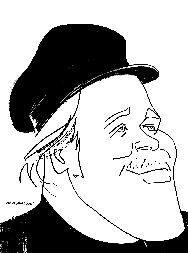
|
|
|
Caricature of Glenn Loney by Sam Norkin. |
|
Please click
on " * " to skip to each subject in this index:
The Devonshire Inheritance: *
Five Centuries of Collecting at Chatsworth *
Splendors of the Renaissance: *
Princely Attire in Italy *
The Subway at 100: *
General William Barclay Parsons *
And the Birth of the NYC Subway *
HOME SEWN: *
Three Centuries of Stitching History *
Congresswoman Carolyn B. Maloney & *
My America: Art from the Jewish Museum Collection *
Arcadia & Metropolis: *
Masterworks of German Expressionism *
From the Nationalgalerie Berlin *
BYZANTIUM: Faith and Power 1261-1557 *
ROTH TIME: A Dieter Roth Retrospective *
The 2004 Biennial Exhibition *
Big Logo & Identity Changes at Brooklyn Museum: *
Glamour: Fabricating Affluence *
MorphoGenomics: *
The Milgo Experiment in Shaping Surfaces *
At The Bard Graduate Center:
Five Centuries of Collecting at Chatsworth
[Closing June 20, 2004]
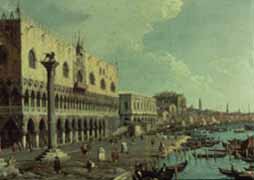 |
| A CANELETTO FROM CHATSWORTH--Duke of Devonshire's Grand Canal on view at Bard Center. |
Although the Family Title is Devonshire-linked, the Earls & Dukes of Devonshire have never in fact been Lords Lieutenants of that shire. Their historic Family Seat is Chatsworth, a long way off from Devon. And the Family Name is Cavendish, not Devonshire. When you visit Britain, do plan to visit the vast Stately Home and gardens of Chatsworth. As well as the nearby Tudor castle-like Hardwick Hall, linked by Bess of Hardwick to Chatsworth.
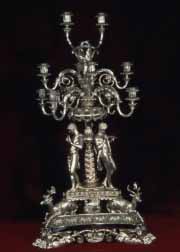 |
| CAVENDISH CANDELABRA--Paul Storr's 1814 creation for the Chatsworth collections. |
In the meantime, however, you can marvel at a number of important, even priceless, treasures which are now on view at the Bard Center, thanks to the gracious loans of the llth Duke & Duchess of Devonshire. Various earls and dukes were not only interested in collecting classical sculptures, rare books, paintings, and objects d'art, but they also maintained and developed the gardens and architecture of Chatsworth. The great house itself is something of a maze of chambers, rooms, and corridors, all crammed with artworks.
The Bard Gallery—housed in a West 86th townhouse—has limited space, but wall-brackets, showcases, and ingeniously hung visuals have permitted more objects than usual to be on display. More than 200 works of art from Chatsworth are on view at Bard. Many of them are from the family's private collections, not on display to day-trippers to the estate. Among these are a letter from Queen Elizabeth I, who took an interest in much-married Bess of Hardwick's personal affairs.
There are paintings by Caneletto and other masters, as well as drawings by Guercino, Raphael, and Rembrandt. The great silver candelabra of Paul Storr is complex in design and impressive in aspect. The Devonshire Parure is rich in gems, with a sort of Victorian Renaissance design. Collecting minerals was also a Cavendish past-time, so some fine crystals are on view.
Over time, some of the family's more passionate ducal collectors put severe financial strains on the estate, and masterpieces have had to be sold. But the present Duke & Duchess are not only collectors but also patrons of artists. The Chatsworth Collections go forward. In this show is Lucien Freud's portrait of the Duchess of Devonshire!
At the CUNY Graduate Center Art Gallery:
[Closing April 24, 2004]
It's an Old Saying that Clothes Make the Man, but it has an historical basis in the old Italian proverb: Drappo e colore fa all'huomo honore. Translated: "Cloth and color lend honor to a man." Of course, in Modern Times—as people have finally understood that Appearances Are Deceiving—the Measure of a Man may instead be his Honesty, Compassion, Courage, Decency, and Merit. Not his Ralph Lauren outfit.
In Renaissance Italy, however, among the nobility personal appearance was very important. Indeed, the quality & cut of one's clothing—perhaps embellished with a family crest, fine lace, jewels, and some gold braid—could do much to give the wearer a sense of distinctive identity. And it would certainly have that effect of others.
At the CUNY Grad Center's Art Gallery, there are now on view a number of richly embellished Renaissance costumes, most based on paintings of royals and nobles. These were confected in wonderfully recreated period fabrics and trims by the King Studio of Reggio Emilia. They were initially shown in 2001 in Isabella d'Este's chambers in the Ducal Palace of Mantua. Since then, they've toured through Europe, Canada, and Latin America. This is their first venue in the United States.
Newly created for New York are impressive outfits for Margherita Gonzaga and Costume for a Princess, both based on Pisanello paintings. Notable among the costumes reconstructed for display are those based on Bronzino's portrait of Eleonora di Toledo, Giulio Romano's painting of Margherita Paleologa di Mantua, and the Coronation Robes of Duke Vicenzo I Gonzaga, as portrayed by Rubens.
Other costumes based on masterpieces are from Titian's Federico II Gonzaga and Jacopo da Empoli's Marriage of Eleonora de'Medici and Vicenzo Gonzaga. As very few complete costumes—and not many fabrics—have survived the centuries, it is amazing to see both cloth & clothing sparkling like new—as indeed they are. What is more, the costumes have been made in pieces, as was the custom. There was no such thing as a complete dress that one could simply slip into. Dressing a Great Lady was something of a ritual and required assistance. And of course noblemen required valets or squires to help them dress.
An interesting—but unintentional—adjunct to this exhibition is on view at the Whitney Biennial. It's 89 Seconds at Alcazar, the film Eve Sussman has made of Velázquez painting Las Meninas. You can see costumes such as these on real people moving about a royal chamber in the palace. And you can see how such clothes restricted their bodies, enforcing a kind of regal posture and movement.
At the NYPL's Science, Industry & Business Library:
General William Barclay Parsons
And the Birth of the NYC Subway
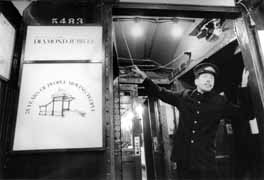 |
| NYC SUBWAY CENTENNIAL CELEBRATION |
[Closing December 31, 2004]
Yes, Virginia, there is a Santa Claus! But he's not the man who will finally make the long-promised Second Avenue Subway a reality. As New York magazine observes this week, he's Peter Kalikow, Chairman of the MTA.
But a hundred years ago, there was another New York Subway visionary, William Barclay Parsons. Unlike Kalikow, he was actually an engineer who knew how to build subways as swiftly and safely as possible. His achievements and his legacy are currently being celebrated in images, artifacts, maps, and texts on Madison Avenue. Actually the Centennial show is—like the nearby IRT station—subterranean: downstairs in the backside of the CUNY Graduate Center. This is the handsome new Science, Industry & Business Library of the NYPL.
General Parsons was not only Chief Engineer of the initial electric subway, which ran some 9 miles from City Hall to 145th Street—with 28 stations. He was also something of a "Renaissance Man," with wide-ranging interests in science, industry, commerce, and culture. A discriminating collector of rare books, he became a Trustee of the New York Public Library. After his death, his rare manuscripts and books were given to the NYPL and have been drawn upon for this exhibition.
The new 1904 subway was not a municipal initiative. It was privately financed: J. P. Morgan was a backer of what was to be called the IRT. The new line helped reduce the daily traffic chaos above ground, as well as getting workers, shoppers, and students to lofts, factories, offices, shops, and schools in record time. In time new lines were added and extended. The BMT was also privately financed and operated. The IND was the first city-operated line.
Parsons' subway-lines and those which foloowed also had a clear influence on the city's cultural life, making it easier and faster to get to the theatres, concert-halls, and museums. These aspects are duly noted in the show—including popular songs about the New York Subways.
At the New-York Historical Society:
Three Centuries of Stitching History
[Closing April 18, 2004]
For lovers & collectors of patchwork quilts, Home Sewn at the New-York Historical Society is not to be missed. But even men and boys might be surprised to discover how important the arts of the needle & thread have been to Manhattan over 300 years. There are over 200 objects in this show, and many of them are much smaller and more delicate than the quilts.
There is a special resonance in this survey of Manhattan sewing skills, as New York City was always the center of the nation's garment and fashion industries. But its domestic application was more immediately important and apparent. Until the middle of the 20th century, a woman who could not sew and cook was often regarded as a poor prospect for marriage and motherhood.
Indeed, in Manhattan, New York State, and American household economies, sewing was an essential. Family clothing had to be made, quilts sewn & tied, tablecloths & napkins hemmed, curtains stitched, doilies and antimacassars crocheted. And repairs constantly had to be made. Few New Yorkers could afford tailors, seamstresses, or even ready-mades.
Singer's Sewing-Machine changed things, mainly in making household sewing easier, but not replacing it. Until 1970, this show points out, Manhattan schoolgirls still had to learn to sew in Home Economics classes. They also learned to cook.
At the Jewish Museum:
Congresswoman Carolyn B. Maloney &
My America: Art from the Jewish Museum Collection
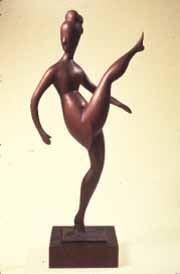 |
| MY AMERICA--Elie Nadelman's Dancer helps Jewish Museum celebrate its centennial. |
[Closing July 25, 2004]
Not only the New York Subway is celebrating a Centennial, but also the Jewish Museum, founded in 1904. Drawing on its own collections, curator Karen Levitov has chosen significant and often powerful works which demonstrate the influences of Jewish immigration—often from Eastern Europe—and of Jewish assimilation into the life and culture of the new country. My America visually surveys how the existing culture affected Jewish artists, but it also demonstrates how they, in turn, significantly influenced, even changed, the development of American art well into the Post War era.
Among the 70 artworks are paintings, sculptures, photos, and drawings by such noted artists as Larry Rivers, Ben Shahn, Albert Bloch, Adolph Gottlieb, Jacques Lipchitz, Alfred Stieglitz, Elie Nadelman, and Raphael Soyer. Obviously, not all the artists on view were immigrants. Some were first-generation Jewish-American artists. Still insecure about studying art at home, many Americans early in the century went to Paris, London, or even Italy to study. Some even stayed abroad. One notable in this exhibition is Sir Jacob Epstein, born on the Lower East Side, but knighted in Britain.
Curator Levitov emphasizes the strong support many Jewish artists demonstrated in their artwork for Social Justice: fair treatment of workers, minorities, and dissidents. This makes the show something of an American Social-History, as well as providing the opportunity for visitors to study important artworks which are too seldom on view.
Among the more impressive works displayed: Saul Baizerman's powerful Crucifixion, Epstein's A Hester Street Crowd, William Gropper's Two Senators, Hananiah Harari's The Dictators, Chaim Gross's abstract sculpture Lindbergh and Hauptmann Trial, and Raphael Soyer's Dancing Lesson.
Although the much-admired U. S. Congresswoman Carolyn B. Maloney is not a Jewish-American artist, she is certainly an admirer of these multi-talented men and women. What is more, she has long been an ardent advocate of the Jewish Museum and its role in promoting education and culture in New York, especially in for schoolchildren. At the press-preview, she expressed her thoughts on this and presented Museum Director Joan Rosenbaum with a very special American Flag. This had been recently flown over the U. S. Capitol in celebration of the Museum & its Centennial. She also shared the remarks she has entered into the Congressional Record, saluting the Museum.
Congresswoman Maloney didn't say how long that flag flew over the Capitol dome. Was it an all-day event? Or only an hour? Ten minutes? If it becomes too widely known that your Senator of Congressman can give your organization or event this very special extra boost, flags might soon be shooting up and down that flagpole every minute or so…
At the Neue Galerie:
Masterworks of German Expressionism
From the Nationalgalerie Berlin
[Closing June 7, 2004]
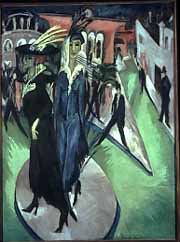 |
| BERLIN STREET-WALKERS ON POINT--Kirchner's Potsdamer Platz at the Neue Galerie. |
Although the great German capital of Berlin was already a teeming metropolis at the beginning of the 20th century, the explosion of industrialization—feeding the Kaiser's lust for expansion & conquest—made it even more of an urban pressure-cooker. It was not initially welcoming to the developing Expressionist Movement, some of whose artists preferred to sketch and paint in arcadian rural locales such as the area around Bavarian Murnau—home-base for Gabriele Münter & Vassily Kandinsky. Or the shores of the Baltic, or even the Moritzburg waters near Dresden.
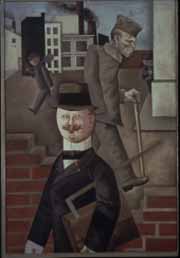 |
| GERMAN EXPRESSIONISM--George Grosz's Gloomy Day on loan from Berlin. |
Oddly enough, Berlin has its own almost integral Arcadias. Its territory includes both forests and lakes, such as the Wannsee. But when the Expressionists began to flower in Berlin, it was often the seamier side of life in the Big City and the Weimar Republic that captured their interest. Rather than the idyllic…
The new show at the Neue Galerie is drawn from the collections of the Nationalgalerie in Berlin, a museum which has itself experienced the turbulent history of both city and country. In fact, the Berlin National Gallery has the remnants of Adolf Hitler's personal art-collection in its vaults. But these have no place in the current show, for the Führer hated Expressionism, and especially die Neue Sachlichkeit—or New Objectivity. [I was permitted to photograph these often depressing testaments to Nazi Taste when the paintings were in the Customs vaults in Munich and later on when they were publicly displayed in Weimar, during its year as Culture City of Europe.]
The New York selection of Expressionist canvases does include some bucolic works, but the most powerful visions are those of life in the city and of the corruption which flourished between the Wars. Otto Dix's Skat Players and George Grosz's Gloomy Day are memorable in this regard.
Ernst Ludwig Kirchner's sharp-angled pre-war Potsdamer Platz dates from 1914, showing two monumental street-walkers on a round traffic island—with much smaller men in dark suits in the background. This is balanced by earlier, more innocently erotic visions of women by Erich Heckel and Max Pechstein.
This show, seen in the larger context of the Neue Galerie's impressive collections of Jugendstil and modern German-Austrian art, has a special resonance. Drawings and painting of Egon Schiele and Emil Nolde offer an interesting complement.And do not forget to have Viennese Coffee and some Apfelstrüdel in the gallery's Jugendstil Cafe Sabarski!
At the Metropolitan Museum of Art:
BYZANTIUM: Faith and Power 1261-1557
[Closing July 4, 2004]
 |
| ICONIC CHRIST--Byzantine treasure on view at Metropolitan. |
In the wake of Mel Gibson's maso-sadistic film culminating in the Crucifixion, rumors are flying that Stephen Spielberg will answer his cinematic intolerance with a film or films on the Christian Crusades. Considering the number and varied horrors of Pope-encouraged & endorsed Crusades over the centuries of the aptly titled Dark Ages, there is ample subject-matter for an entire TV series. The Children's Crusade should certainly be chilling.
But the infamous Roman Catholic Crusade which didn't get all the way to the Holy Land could be a Big-Budget Spectacular. This was the Fourth Crusade, a military expedition of Christian Knights which got only as far as Constantinople and decided to attack Eastern Orthodox Christians, instead of Arabs. The killing and pillage was horrendous, as the great city was laid waste. But, after all, didn't these people and their obstinate clerics deserve it? They didn't acknowledge the absolute rule of the Roman Pope. And they preferred their liturgy in Greek, rather than Latin. Certainly not a Mel Gibson Choice.
The splendid new Byzantine exhibition at the Met Museum—third and last in a series—begins with the expulsion of these Crusaders in 126l. Michael VIII Palaiologos led his victorious Byzantine army into Constantinople bearing the sacred icon of the Virgin Hodegetria, protectress of the city. This rebirth sparked a renewed development of Byzantine religious art of great beauty whose influence spread far beyond what is today Istanbul.
Unfortunately, this was not to last—though a number of the artworks have endured. In 1453, Muslim Turkish forces took the great city and drove out the Orthodox artists, poets, and theologians who were not killed.
The Prophet—echoing one of the Ten Commandments—had forbidden his followers to make images of Man and Beast alike. Nor were they to admire or collect them. Thus it was that many important manuscripts and artworks found safety in Catholic lands.
But the influence of Byzantium on Orthodox communities, churches, and religious foundations in Greece and elsewhere in the East had been strong, and much was preserved. Even though the Ottoman Turks reached the gates of Vienna—where they were ultimately defeated, saving Western Christian Civilization for centuries—they didn't tend to harass adherents of other religions than Islam, as long as taxes were paid and laws obeyed.
Thus the Metropolitan Museum is able to show 40 magnificent old icons from the Holy Monastery of St. Catherine in Sinai. This historic retreat is in Egyptian territory, a possibly dangerous place for arts-tourism or even pilgrimages now. But still well worth the journey, for this Fourth Century foundation is now the oldest active monastery in the world. At the Met opening, Archbishop Damianos of Sinai offered the Prayer of Consecration.
His All Holiness Ecumenical Patriarch Bartholomew, Spiritual Head of the Worldwide Orthodox Christian Church, also lectured at the Met on Byzantine Icons: A Legacy for Humanism. The beauties of the icons, carvings, and images on display clearly can have transcendent significance for Christians of many faiths—although there are some Protestant Fundamentalists who will be unmoved. [They do not like Graven Images or Idols any more than Muslims do.] But viewers need not be religious to be amazed at the skill and the vision of the various artists who created these often glowingly golden images.
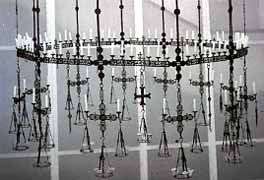 |
| LET THERE BE LIGHT!--Immense Byzantine Chandelier at the Met Museum. |
This is a very large-scale show for the Met, including more than 350 masterpieces, many never before shown abroad. Loans have been made from Muslim Egypt and Turkey, as well as longtime Orthodox territories as Greece, Bulgaria, Serbia, Montenegro, Romania, Macedonia, and Russia, where Byzantine Christian influences long survived the 1453 expulsion from Constantinople. Over 30 nations are represented, for important artworks have found their way into collections in France, Britain, Germany, the United States, and Italy—notably the Vatican.
Including the Met, more than twenty American collections are represented in this show, which has taken over seven years to organize. Not only have arrangements for loans been complicated, but some installations have required innovative planning for the spaces available. A case in point is the immense Byzantine chandelier, 15 feet high and ll feet in diameter. It is hung at eye-level, not overhead, and almost fills one of the exhibition chambers. It is on loan from Munich's Museum for Pre- and Early History. It has been assembled at the Met from its 1100 constituent pieces.
The richness and intricacy of the embroideries and jeweling of some Byzantine liturgical robes rival anything in the Western Church's treasuries. Many of the icons of Christ, the Crucifixion, and the Blessed Virgin & Holy Child are quite different in style and inspiration from those made in the West.
Such styles can still be seen in icons painted by monks on Mount Athos, though these modern copies often seem stereotypical, rather than inspired. When I was on Athos—No Women Allowed!—in 1959, a very old monk took me aside, offering to sell me an obviously very old icon. This was forbidden—too many treasures had already left Mount Athos monasteries that way—so I refused the offer.
At the Met, you can look as long as you like. But don't touch or snatch. There is, after all, a magnificent catalogue, plus posters and pictures of icons to help you remember this impressive show.
At MoMA QNS & P. S. 1 Contemporary Art Center:
ROTH TIME: A Dieter Roth Retrospective
[Closing June 7, 2004]
 |
| CHOCOLATE HEAD--Dieter Roth's molded self-portrait bust at MoMA QNS. |
The late Dieter Roth was an adventurous Swiss artist who seems to have tried his hand at a wide variety of art-forms, techniques, and gimmicks. He also had a sense of humor, occasionally using name of the famous French encyclopedist DIDEROT, which sounds much the same as his own name in German. His humor had a sharp, satiric side as well. Books that he hated he chopped up and stuffed into salami-skins. Martin Walser was one victim of this form of Literary Criticism: A wurst-and-a-half in a frame, titled Literaturwurst (Martin Walser: Halbzeit).
Roth painted, he potted, he welded, he sawed. He even did tapestry—with Ingrid Wiener. His fairly recognizable Self-Portrait in wools [Grossser Teppich] hangs on a frame and can be admired from both sides. But there's another tapestry that's anything but realistic.
Some sketches and painted images show a brilliant mastery of representation—even of representing imaginary things as real. But many of his constructions, assemblages, and installations are anything but. Some are bizarre concoctions of Found Objects. Some offer the same visual effect as smashing a piano with a sledge-hammer.
 |
| LITTLE BIT OF EVERYTHING SCULPTURE--Dieter Roth's immense Gartenskulptur room-filler at P. S. 1 in Queens. |
The galleries of MoMA QNS are crowded with Roth Works, including manuscripts, books, and videos. There is so much, in fact, that the show spills over into P. S. 1—which requires a shuttle-bus to reach. Here in this former NYC Public School—saved for the Contemporary Arts by the late Brendan Gill, among other champions—the wooden side of his studio has been reconstructed. His workbench has been set up as well, along with samples of his supplies and working-materials. These include the casts for the dog's-heads he made for an unusual work. He also cast a self-portrait head as a "Bird-Seed Bust," or Vogelfutterbüste.
One room at P. S. 1 has a curved bank of 131 video-monitors. You can see Roth at work—among other Rothian images. Most overwhelming is the immense assemblage which fills an entire room. This is Gartenskulptur, which looks something like a junk-wagon caravan with a dino's head. Its components include wood, wire, rope, metal, furnishings, plants, painting utensils, liquids in glasses, a broken TV set, video monitors, clothing, pigments, foods, toys, photos, drawings, construction materials, etc., etc., etc.
MoMA curator Gary Garrels says, in part: "…His work has a diversity and a logical coherence that establish him as one of the most singular and important artists of the second half of the century." No wonder Dieter Roth is so much admired—and eagerly collected—in Europe, even if he's largely unknown in America. Just think of it: One of the most singular and important artists of the second half of the century! [Yes, and there are still Weapons of Mass Destruction hidden in Iraq…]
At the Whitney Museum of American Art:
[Closing May 30, 2004]
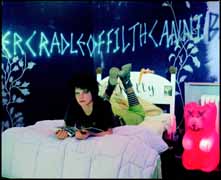 |
| Sue de Beer, still from "Hans and Grete," 2002 |
Look where it comes again! No, not Hamlet's Father's Ghost, but the Whitney Biennial! It pales in comparison with this past summer's Venice Biennale, but then the Whitney has to make do with some cramped Marcel Breuer galleries and a few locales in Central Park. Both the highly controversial David Ross and the less-so Maxwell Anderson are gone from the Whitney's helm, but it is lower-level curators who finally decide what and whom to include in this survey of new work and new ideas in American Art. In any case, this was being planned while Anderson was still on board. If anything, though, it is tamer, less adventurous, less exciting, less interesting than previous editions. Even with no less than 108 artists' works on view…
In the Whitney lobby, something even more scandalous is promised upstairs with the image of Liz Craft's Death Rider biker. He's a skeleton in bronze on a Harley, with a topless girlfriend. Topless, in that she has no head. The bike has a beehive-engine and a pine-cone gas-tank. Is this an Environmental Issue?
In the chamber by the elevators, where Jay DeFeo's The Rose was recently on view, the objects of admiration are two white marble models of Los Angeles Freeway Intersections. OK, why not?
Then there are the usual suites of small photos and canvases with stuff glued to them. Collages, Assemblages. You Name It! Often, not memorable. A question worth asking at such surveys: Would you want to buy any of these works to live with in your home?
Obviously, this is not a concern of artists who create immense installations or wall-swallowing canvases. Their market-target has to be museums or lobbies & board-rooms of major US Corporations with tax-write-offs for their Art Collections.
Mounting unusual installations in small chambers—especially if the word gets out that they are really interesting—can create traffic-problems. Yayoi Kusama's Fireflies on the Water is certainly one of these. It is magical.
The increasing incursions of video-art in contemporary arts surveys are often boring and unimaginative, but they do seem to be displacing plastic and graphic arts. The best of these—in fact, one of the most intriguing works in the entire Biennial—is 89 Seconds at Alcazar. This is Eve Sussman's film of actors dressed in 16th century Spanish Court costumes, moving slowly, graciously as Velázquez is working on his master-canvas, Las Meninas.
Rather than continue this catalogue, your reporter sees by the clock that it's time to rush off to the Barrymore Theatre to review Sly Fox. This is the problem in trying to report on both theatres and museums—as well as index thousands of INFOTOGRAPHY photos—there isn't enough time for anything, especially contemplation.
Besides, it's almost as difficult to describe some cutting-edge artworks as it must be to imagine them in the first place. Go see the Biennial and make your own evaluations: there are certainly enough new creations to pique your interest.
Big Logo & Identity Changes at Brooklyn Museum:
For many decades, the Second Museum in America—after the Metropolitan—was content to call itself the BROOKLYN MUSEUM: This generic identify was entirely appropriate, for the Museum, like the Met, collected not only paintings and sculptures, but cultural artifacts & treasures. Its Egyptian Middle Kingdom Collection was one of the finest in the world.
Archeological and ethnographical expeditions had also enriched the extensive Museum holdings. In this regard, it was more like the American Museum of Natural History in Manhattan. In fact, it's not unfair to think of the Brooklyn Museum as a combination of the best of both the Met and the AMNH!
But—perhaps not wanting to be thought of as a catch-all of collections—the Museum fairly recently changed its name to the Brooklyn Museum of Art. This looked very much like a desperate attempt to re-package itself to appeal more strongly to tourists and Manhattanites.
The name-change co-incided with a series of headline-grabbing cutting-edge art shows. After the Museum's astonishing SENSATIONS—which outraged Mayor Rudy Giuliani so much that he tried to shut down the museum, or at least shut off its city funding—it achieved not only nationwide but also international attention.
But this month the Museum will open its stunning new entrance & plaza—as well as spotlight new designs for major installations. To herald these changes—part of the Master-Plan for the future development of the Museum—the new name of the Museum will now be the old one again: The Brooklyn Museum!
Instead of the previous BMA print-logo, there will now be a new "Graphic Identity" for the Museum. This new logo features the bare outline of the Letter B—without serifs—in the center of what looks like Six Blue Cats plugged into an electric-socket. This jagged design is so complex—computer-generated, no doubt—that anyone who wants to copy it free-hand is sure to fail.
The combination of the New Logo and the Old Name obviously relate to what Director Arnold Lehman calls "the visitor-centered goals of the Museum." This statement also suggests that funding major anthro-ethnic expeditions is now something in the Museum's past. That's all rather Politically Incorrect in any case. It's now patronizing & condescending to the Peoples of Developing Third World Nations & Cultures roam the world, collecting their bowls, beads, and bows.
As for the new Logo, Museum spokes-persons note the "unchanging capital B" will be shown against a "background of eight different formal seals—or splashes—in one brilliant color, an electric cyan-blue." The seals are to be used "in a random fashion, emphasizing the uniqueness of the Museum."
This logo was created by a design-firm called 2X4. Its Creative Director, Michael Rock, says of the nervous image: "The new logo is intended to reflect flexibility, change, surprise, and accessibility. The dynamic seal is designed to represent a museum that is willing to break the mold of the familiar and commit to a program of continuous experimentation, openness and, most, important, constant reinvention."
That's all very well, but the problem about the Brooklyn Museum for many Manhattan art-lovers is that it is nonetheless still in Brooklyn.
SF MoMA Previews New Show for NYC Press:
Glamour: Fabricating Affluence
[Opening in San Francisco October 9, 2004]
 |
| from Glamour at SF MoMa |
The San Francisco Museum of Modern Art for many years was housed virtually in the attic of the Veterans Building at Civic Center, across from the War Memorial Opera House. Now it has its own Post-Modernist home in downtown San Francisco, across the street from the Moscone Convention Center.
But SF MoMA has long been second only to Manhattan's MoMA in its collections, perspectives, initiatives, and exhibitions. In order to make sure New York knows about this, the Bay Area museum's chieftains and press-people make an annual pilgrimage to New York to preview forthcoming shows. Previously, they made a handsome presentation for their Diane Arbus photography show—which will soon be on view in Manhattan at the Met, no less.
Curated by Joseph Rosa, the upcoming exploration of Glamour promises to be both innovative and instructive. Customarily, the idea of Glamour is linked to Hollywood Stars, their glamourous gowns and hairdo's—and, of course, their elegantly outfitted male escorts. But those images—especially the Glamour of the Jazz Age and the Art Deco Thirties—are enhanced by sleek automobiles, Moderne cocktail-lounges, and breathtaking interiors such as the Radio City Music Hall foyer.
Glamour in Fashion will therefore be balanced with Glamour in Industrial Design and in Architecture. For those who may find it difficult to see glamour in a Caterpillar Tractor or San Quentin Prison, there may well be many surprises in store in San Francisco.
Actually, neither of those are on Curator Rosa's schedule. And, although the last 70 years will be surveyed, most of those decades will be background for showcasing contemporary creativity. On view will be a 1965 Jaguar coupe and a 2004 Bentley—rather than a 1920s Bugatti or a Cord—so this show may in part be about Product Placement.
Some 125 objects or visuals will be on display, from the architecture of Edward Durrell Stone to the frocks of Gianni Versace. Rosa notes that the idea of Excess is linked to Glamour: Inclusion of Design Elements not required by Function. As both architecture and industrial-design have been for decades impacted by the dictum: FORM FOLLOWS FUNCTION, it will be interesting to see what Rosa has selected in buildings and machines that goes beyond the merely functional, as in Bauhaus and International Style architecture.
Actually, the clean, sleek, gleaming, streamlined outlines of some major Art Deco buildings of the 1930s are both formally functional and wonderfully Glamourous—without being unduly excessive… Some of the more modern buildings Rosa has chosen for this show really are not all that glamourous: notably the three major components of Lincoln Center. Big Ugly Glass/Steel/Stone Boxes!
At the Muni Art Society Urban Center:
The Milgo Experiment in Shaping Surfaces
[Closing April 30, 2004]
It may already be too late for Curator Joseph Rosa to invite Haresh Lalvani to show his MorphoGenomic AlgoRhythms at SF MoMA. But they are certainly Glamourous in an entirely new way. Not since the streamlining of Moderne and Art Deco has there been such distinctive and exciting New Look in architectural design. With the possible exception of Zia Hadid's remarkably innovative creations, such as her new Cincinnati Museum of Contemporary Art…
Lalvani's new architectural forms are, he says, "algorithmically derived from the higher mathematics of surfaces." AlgoRhythms are complex curved metal surfaces for applications in architecture. On paper, or on computer print-outs, Lalvani's designs look like formal fantasies: amazing, stunning—but impossible to translate into metallic reality.
Fortunately, he has found remarkable partners in Brooklyn-based MILGO/BUFKIN, who can manufacture infinite variations in metal of a basic algorhythmic design. A number of these are now on view at the Municipal Art Society's Urban Center, on Madison Avenue in the Villard Houses, behind St. Patrick's Cathedral.
Although these could conceivably be employed structurally, Lalvani is promoting them essentially as cladding, divider-walls, or outdoor "umbrellas." A simple support-column can be transformed into a remarkably twisted fluted spiral with such a cover-cladding. In fact, an entire floor with a number of columns can have each one with a variation of the same design.
Milgo/Bufkin's fabrication process uses a new form of mass-customization so that each item can be made differently—variations on a basic design—which eventually will operate with the same speed and efficiently as mass-production of identical items.
For more information about the theoretical and practical aspects of Lalvani's discoveries, try these addresses: milgomail@aol.com or www.milgo-bufkin.com/algorhythms.